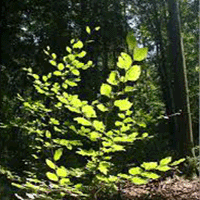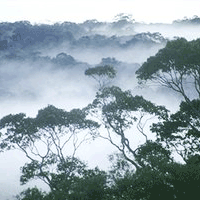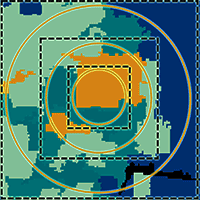We examined the spatial diversity of young growth established after the catastrophic windthrow occurred in 2002 in the northeastern part of Poland. Our observations and measurements were conducted on permanent circular measurement plots located in the Szast Protected Forest (continental lowland temperate forests) that were established 3 years after the windstorm and left to natural succession. We evaluated the spatial indices characterizing the four main aspects of stand structure: the spatial arrangement of seedlings and saplings, species mingling, tree size diversity at the local spatial scale and the overall structural complexity index. The calculations were conducted in parts of the forest with differing severity of disturbance. The obtained results indicated the prevalence of a random arrangement of young growth. Clumps of regeneration were observed to a lesser degree in all parts of the forest. The species diversity was moderate and was the highest in the slightly or severely disturbed stands. Scots pine formed homogenous groups of regeneration and oaks were intermingled among other tree species. The height of the natural regeneration was moderately or highly differentiated in all stands. The overall structural diversity index showed that stand regeneration in the slightly or moderately disturbed stands was more differentiated than the young growth in the severely disturbed stands. The size differentiation of young growth is a long-lasting process and thus should be considered in practices aimed at the re-growing of areas after a natural disturbance. This process might be used to the replace monocultures with more diversified forests even in poor forest site types.
Keywords
, , , ,
Citation
Szmyt J, Dobrowolska D (2016). Spatial diversity of forest regeneration after catastrophic wind in northeastern Poland. iForest 9: 414-421. - doi: 10.3832/ifor1699-008
Academic Editor
Matteo Garbarino
Paper history
Received: May 06, 2015
Accepted: Nov 05, 2015
First online: Jan 29, 2016
Publication Date: Jun 01, 2016
Publication Time: 2.83 months
© SISEF - The Italian Society of Silviculture and Forest Ecology 2016
Open Access
This article is distributed under the terms of the Creative Commons Attribution-Non Commercial 4.0 International (https://creativecommons.org/licenses/by-nc/4.0/), which permits unrestricted use, distribution, and reproduction in any medium, provided you give appropriate credit to the original author(s) and the source, provide a link to the Creative Commons license, and indicate if changes were made.

Breakdown by View Type
(Waiting for server response...)
Article Usage
Total Article Views: 49711
(from publication date up to now)
Breakdown by View Type
HTML Page Views: 41257
Abstract Page Views: 3167
PDF Downloads: 4017
Citation/Reference Downloads: 24
XML Downloads: 1246
Web Metrics
Days since publication: 3607
Overall contacts: 49711
Avg. contacts per week: 96.47
Article Citations
Article citations are based on data periodically collected from the Clarivate Web of Science web site
(last update: Mar 2025)
Total number of cites (since 2016): 11
Average cites per year: 1.10
Publication Metrics
by Dimensions ©
Articles citing this article
List of the papers citing this article based on CrossRef Cited-by.
(1)
Allen MS, Thapa V, Arévalo JR, Palmer MW (2012)Windstorm damage and forest recovery: accelerated succession, stand structure, and spatial pattern over 25 years in two Minnesota forests. Plant Ecology 213: 1833-1842.
CrossRef |
Gscholar
(2)
Arévalo JR, DeCoster JK, McAlister SD, Palmer MW (2000)Changes in two Minnesota forest during 14 years following catastrophic windthrow. Journal of Vegetation Science 11: 833-840.
CrossRef |
Gscholar
(3)
Budzáková M, Galvanek D, Littera P, Sibik J (2013)The wind and fire disturbance in Central European mountain spruce forests: the regeneration after four years. Acta Societatis Botanicorum Poloniae 82: 13-24.
CrossRef |
Gscholar
(4)
Dobrowolska D (2007)Odnowienie naturalne lasu w drzewostanach uszkodzonych przez wiatr na terenie pólnocno-wschodniej Polski [Natural regeneration of forests in stands damaged by wind in north-eastern Poland]. Lesne Prace Badawcze 2: 45-60. [in Polish]
Gscholar
(5)
Dobrowolska D (2008)Odnowienie naturalne na powierzchniach uszkodzonych przez pozar w Nadlesnictwie Rudy Raciborskie [Natural regeneration in fire-damaged plots in the Rudy Raciborskie Forest Division]. Lesne Prace Badawcze 3: 255-264. [in Polish]
Gscholar
(6)
Dobrowolska D (2010)Rola zaburzen w regeneracji lasu. [The role of disturbance in forest regeneration]. Lesne Prace Badawcze 7: 391-405.
Gscholar
(7)
Dobrowolska D (2015)Forest regeneration in northeastern Poland following a catastrophic blowdown. Canadian Journal of Forest Research 45: 1172-1182.
CrossRef |
Gscholar
(8)
Falinska K (1996)Ekologia roslin [Vegetation ecology]. Wydawnictwo Naukowe PWN, Warszawa, Poland, pp. 454. [in Polish]
Gscholar
(9)
Fischer A, Marshall P, Camp A (2013)Disturbances in deciduous temperate forest ecosystems of the northern hemisphere: their effects on both recent and future forest development. Biodiversity Conservation 22: 1863-1893.
CrossRef |
Gscholar
(10)
Gadow KV (1993)Zur Bestandesbeschreibung in der Forsteinrichtung [New variables for describing stands of trees]. Forst und Holtz 48: 602-606. [in German]
Gscholar
(11)
Holzmueller EJ, Gibson DJ, Suchecki PF (2012)Accelerated succession following an intense wind storm in an oak-dominated forest. Forest Ecology and Management 279: 141-149.
CrossRef |
Gscholar
(12)
Ilisson T, Köster K, Vodde F, Jõgiste K (2007)Regeneration development 4-5 years after a storm in Norway spruce dominated forests, Estonia. Forest Ecology and Management 250: 17-24.
CrossRef |
Gscholar
(13)
Kint V, Van Meirvenne M, Nachtergale L, Geudens G, Lust N (2003)Spatial methods for quantifying forest structure development: a comparison between nearest-neighbor indices and variogram analysis. Forest Science 49: 36-49.
Online |
Gscholar
(14)
Kulakowski D, Veblen TT (2003)Subalpine forest development following a blowdown in the Mount Zirkel Wilderness, Colorado, USA. Journal of Vegetation Science 14 (5): 653-660.
CrossRef |
Gscholar
(15)
Koukoulas S, Blackburn GA (2005)Mapping individual tree location, height and species in broadleaved deciduous forest using airborne LiDAR and multi-spectral remotely sensed data. International Journal of Remote Sensing 26: 431-455.
CrossRef |
Gscholar
(16)
Kuuluvainen T, Kalmari R (2003)Regeneration microsites of
Picea abies seedlings in a windthrow area of a boreal old-growth forest in southern Finland. Annales Botanici Fennici 40 (6): 401-413.
Online |
Gscholar
(17)
Kuuluvainen T, Juntunen P (1998)Seedling establishment in relation to microhabitat variation in a windthrow gap in a boreal
Pinus sylvestris forest. Journal of Vegetation Sciences 9: 551-562.
CrossRef |
Gscholar
(18)
Lähde E, Laiho O, Norokorpi Y, Saksa T (1999)Stand structure as the basis of diversity index. Forest Ecology and Management 115: 213-220.
CrossRef |
Gscholar
(19)
Močalov SA, Lässig R (2002)Development of two boreal forests after large-scale windthrow in the Central Urals. Forest Snow and Landscape Research 77: 171-186.
Online |
Gscholar
(20)
McElhinny C, Gibbons P, Brack C, Bauhus J (2006)Forest and woodland stand structural complexity: its definition and measurement. Forest Ecology and Management 218: 1-24.
CrossRef |
Gscholar
(21)
Mitchell SJ (2013)Wind as a natural disturbance agent in forests: a synthesis. Forestry 86 (2): 147-157.
CrossRef |
Gscholar
(22)
Mosandl R, Kleinert A (1998)Development of oaks (
Quercus petraea (Matt). Liebl.) emerged from bird-dispersed seeds under old-growth pine (
Pinus silvestris L.) stands. Forest Ecology and Management 106: 35-44.
CrossRef |
Gscholar
(23)
Mroczkiewicz L, Trampler T (1964)Typy siedliskowe lasu w Polsce [Forest site types in Poland]. PWRiL, Warszawa, Poland, pp. 1-160. [in Polish]
Gscholar
(24)
Nachtergale L, Schrijver DE, Lust N (1997)Windthrow, what comes after the storm? Silva Gandavensis 62: 80-89.
Gscholar
(25)
Nagel TA, Svoboda M, Diaci J (2006)Regeneration patterns after intermediate wind disturbance in an old-growth
Fagus-Abies forest in southeastern Slovenia. Forest Ecology and Management 226: 268-278.
CrossRef |
Gscholar
(26)
Oliver CD, Larson BC (1996)Forest stand dynamics. John Wiley and Sons, New York, USA, pp. 544.
Gscholar
(27)
Panayotov M, Kulakowski D, Laranjeiro Dos Santos L, Bebi P (2011)Wind disturbances shape old Norway spruce-dominated forest in Bulgaria. Forest Ecology and Management 262: 470-481.
CrossRef |
Gscholar
(28)
Pastorella E, Paletto A (2013)Stand structure indices as tools to support forest management: an application in Trentino forests (Italy). Journal of Forest Science 4: 159-168.
Online |
Gscholar
(29)
Peterson CJ, Leach AD (2008)Salvage logging after windthrow alters microsite diversity, abundance and environment, but not vegetation. Forestry 81 (3): 361-376.
CrossRef |
Gscholar
(30)
Pommerening A (2002)Approaches to quantifying forest structures. Forestry 75: 305-324.
CrossRef |
Gscholar
(31)
Pommerening A (2006)Evaluating structural indices by reversing forest structural analysis. Forest Ecology and Management 224: 266-277.
CrossRef |
Gscholar
(32)
Pukkala T, Gadow KV (2012)Forest structure and diversity. In: “Continuous cover Forestry” (Pukkala T, Gadow KV eds). Springer Science+Business Media BV, Dordrecht, Heidelberg London, New York, pp. 296.
Gscholar
(33)
Shorohova E, Fedorchuk V, Kuznetsova M, Shvedova O (2008)Wind-induced successional changes in pristine boreal
Picea abies forest stands: evidence from long-term permanent plot records. Forestry 81 (3): 335-359.
CrossRef |
Gscholar
(34)
Schönenberger W (2002)Post windthrow stand regeneration in Swiss mountain forests: the first ten years after the 1990 storm Vivian. Forest Snow and Landscape Research 77 (1/2): 61-80.
Online |
Gscholar
(35)
Spathelf P, Maaten E, Maaten-Theunissen M, Campioli M, Dobrowolska D (2014)Climate change impacts in European forests: the expert views of local observers. Annals of Forest Science 71 (2): 131-137.
CrossRef |
Gscholar
(36)
Stoyan D, Penttinen A (2000)Recent applications of point process methods in forestry statistics. Forest Science 15: 61-78.
Online |
Gscholar
(37)
Svoboda M, Pouska V (2008)Structure of a Central-European mountain spruce old-growth forest with respect to historical development. Forest Ecology and Management 255 (7): 2177-2188.
CrossRef |
Gscholar
(38)
Szewczyk J, Szwagrzyk J (1996)Tree regeneration on rotten wood and on soil in old-growth stand. Vegetatio 12: 37-46.
CrossRef |
Gscholar
(39)
Szmyt J, Ceitel J (2011)Zróznicowanie przestrzenne i grubosciowe drzew w niepielegnowanych drzewostanach sosnowych o róznym zageszczeniu poczatkowym [Spatial and size diversity of trees in untended pine stands of different initial density]. Sylwan 11: 749-760. [in Polish]
Gscholar
(40)
Szmyt J (2012)Spatial structure of managed beech-dominated forest: Applicability of nearest neighbors indices. Dendrobiology 68: 69-76.
Online |
Gscholar
(41)
Szmyt J (2014)Spatial statistics in ecological analysis: from indices to functions. Silva Fennica 48: artID 1008.
CrossRef |
Gscholar
(42)
Szmyt J, Korzeniewicz R (2014)Czy naturalne procesy ekologiczne w juwenilnej fazie rozwoju drzewostanu zalozonego sztucznie róznicuja jest strukture przestrzenna? [Do natural processes at the juvenile stage of stand development differentiate the spatial structure of trees in artificially established forest stands?] Lesne Prace Badawcze 75: 171-179. [in Polish]
Gscholar
(43)
Thaxton JM, DeWalt SJ, Platt WJ (2007)Spatial patterns of regeneration after hurricane Andrew in two south Florida fringe mangrove forests. Biological Sciences 2: 148-156.
Online |
Gscholar
(44)
Ulanova NG (2000)The effect of windthrow on forests at different spatial scales: a review. Forest Ecology and Management 135: 155-167.
CrossRef |
Gscholar
(45)
Uriarte M, Canham CD, Thompson J, Zimmerman JK, Brokaw N (2005)Seedling recruitment in a hurricane-driven tropical forest: light limitation, density-dependence and the spatial distribution of parent trees. Journal of Ecology 93: 291-304.
CrossRef |
Gscholar
(46)
Vodde F, Jõgiste K, Gruson L, Ilisson T, Köster K, Stanturf J (2010)Regeneration in windthrow areas in hemiboreal forests: the influence of microsite on the height growths of different tree species. Journal of Forest Research 15 (1): 55-64.
CrossRef |
Gscholar
(47)
Vorčak J, Merganic J, Saniga M (2006)Structural diversity change and regeneration processes of the Norway spruce natural forest in Babia hora NNR in relation to altitude. Journal of Forest Science 52: 399-409.
Online |
Gscholar
(48)
Xi W, Peet RK, Urban DL (2008)Changes in forest structure, species diversity and spatial pattern following hurricane disturbance in a Piedmont North Carolina forest, USA. Journal of Plant Ecology 1: 43-57.
CrossRef |
Gscholar
(49)
Wohlgemuth T, Kull P, Wüthrich H (2002)Disturbance of microsites and early tree regeneration after windthrow in Swiss mountain forests due to the winter storm Vivian 1990. Forest, Snow and Landscape Research 47: 17-47.
Online |
Gscholar


















